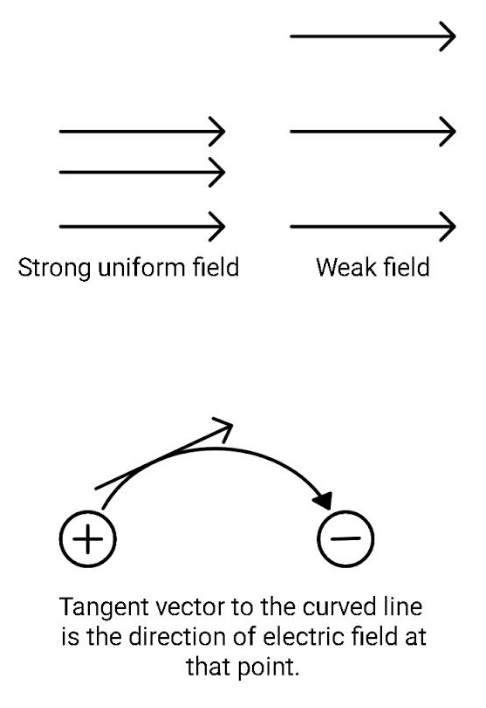
Why should electric field lines never cross each other?
A. Electric field due to a charge at any point is always singular in magnitude.
B. Electric field due to a charge at any point is always singular in direction.
C. Electric fields due to a charge at any point cannot be multi-directional.
D. All of the above
Answer
578.7k+ views
Hint: Electric field lines are imaginary lines or curves that are meant to represent the electric field at various points along the curve. Two field lines cross at that point the electric field intensity will be given by two different vectors.
Complete step by step answer:
We know that, electric field is found by keeping a positive test charge at a point and then finding the direction in which it moves due to the electric force it experiences. Electric field lines are nothing but the trajectories of this positive test charge. They are meant as a mere representation of the electric field intensity. The closer these field lines are, higher will be the force experienced by the unit charge or we can say the electric field intensity will be high. If the field lines appear to be highly separated, the intensity of the field will be weak in such regions. Consider the diagram:

We know that, in a dipole, we observe curved field lines. The tangent vector shown here points to the direction of the electric field at that point. Therefore, if two such lines cross, it would mean that the electric field has two directions at that point. Also, if the two field lines crossed, it would mess up the magnitude as we represent the magnitude by density of field lines.
Therefore the correct answer should be option (D). All of the above.
So, the correct answer is “Option D”.
Note:
Options (B) and (C) are two different ways of expressing the same thing so might cause slight confusion. Also one should know how magnitude is represented with the help of field lines so they have accurate understanding of the correct answer here.
Complete step by step answer:
We know that, electric field is found by keeping a positive test charge at a point and then finding the direction in which it moves due to the electric force it experiences. Electric field lines are nothing but the trajectories of this positive test charge. They are meant as a mere representation of the electric field intensity. The closer these field lines are, higher will be the force experienced by the unit charge or we can say the electric field intensity will be high. If the field lines appear to be highly separated, the intensity of the field will be weak in such regions. Consider the diagram:

We know that, in a dipole, we observe curved field lines. The tangent vector shown here points to the direction of the electric field at that point. Therefore, if two such lines cross, it would mean that the electric field has two directions at that point. Also, if the two field lines crossed, it would mess up the magnitude as we represent the magnitude by density of field lines.
Therefore the correct answer should be option (D). All of the above.
So, the correct answer is “Option D”.
Note:
Options (B) and (C) are two different ways of expressing the same thing so might cause slight confusion. Also one should know how magnitude is represented with the help of field lines so they have accurate understanding of the correct answer here.
Watch videos on
Why should electric field lines never cross each other?
A. Electric field due to a charge at any point is always singular in magnitude.
B. Electric field due to a charge at any point is always singular in direction.
C. Electric fields due to a charge at any point cannot be multi-directional.
D. All of the above
A. Electric field due to a charge at any point is always singular in magnitude.
B. Electric field due to a charge at any point is always singular in direction.
C. Electric fields due to a charge at any point cannot be multi-directional.
D. All of the above

Electric Charges and Fields Class 12 Physics - NCERT EXERCISE 1.7 | Physics NCERT | Vishal Kumar Sir
Subscribe
 Share
Share likes
264 Views
2 years ago
Recently Updated Pages
Master Class 12 English: Engaging Questions & Answers for Success

Master Class 12 Business Studies: Engaging Questions & Answers for Success

Master Class 12 Economics: Engaging Questions & Answers for Success

Master Class 12 Social Science: Engaging Questions & Answers for Success

Master Class 12 Maths: Engaging Questions & Answers for Success

Master Class 12 Chemistry: Engaging Questions & Answers for Success

Trending doubts
What are the major means of transport Explain each class 12 social science CBSE

Which are the Top 10 Largest Countries of the World?

Draw a labelled sketch of the human eye class 12 physics CBSE

Explain sex determination in humans with line diag class 12 biology CBSE

Explain sex determination in humans with the help of class 12 biology CBSE

Differentiate between homogeneous and heterogeneous class 12 chemistry CBSE



 Watch Video
Watch Video
